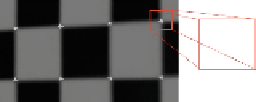Image Processing Reference
In-Depth Information
This detector can be seen as a specification of the detector proposed in Rosten and Drum-
the pixel is analyzed, the computational cost is reduced. Other similar detectors can be found
in Zhao et al. [
17
]
and Sun et al. [
21
].
Figure 2
shows a typical result of this detector over a
chessboard image.
FIGURE 2
X-corner detector response. Light pixels define found corner positions in the im-
age.
Equation
(1)
does not guarantee that only one pixel is classified as a x-corner in its neigh-
borhood. To deal with this problem, the cost described by Equation
(2)
is associated with each
(2)
The classes
dark
and
light
contains the dark and light pixels, respectively. The right corner is
the one with the highest associated cost.
3 Topological filter
The identification of valid corners is an important step because not all x-corners present in the
image belong to the calibration patern. In this work, the identiication of valid x-corners is
made considering the regularity neighborhood of the chessboard image. This problem can be
extended to the task of creating geometric meshes in computer graphics. In a mesh composed
of basic components such as triangles, vertices are connected according to their neighborhood
The Delaunay triangulation is a classic problem in computational geometry. Given a set of
points in a plane, the only valid triangulation is one where the circumcircle of each triangle
closely vertexes. The mesh allows to define the neighborhood of each point.
Figure 3
gives an
lation that runs in time
O
(
n
log(
n
)).


Search WWH ::

Custom Search